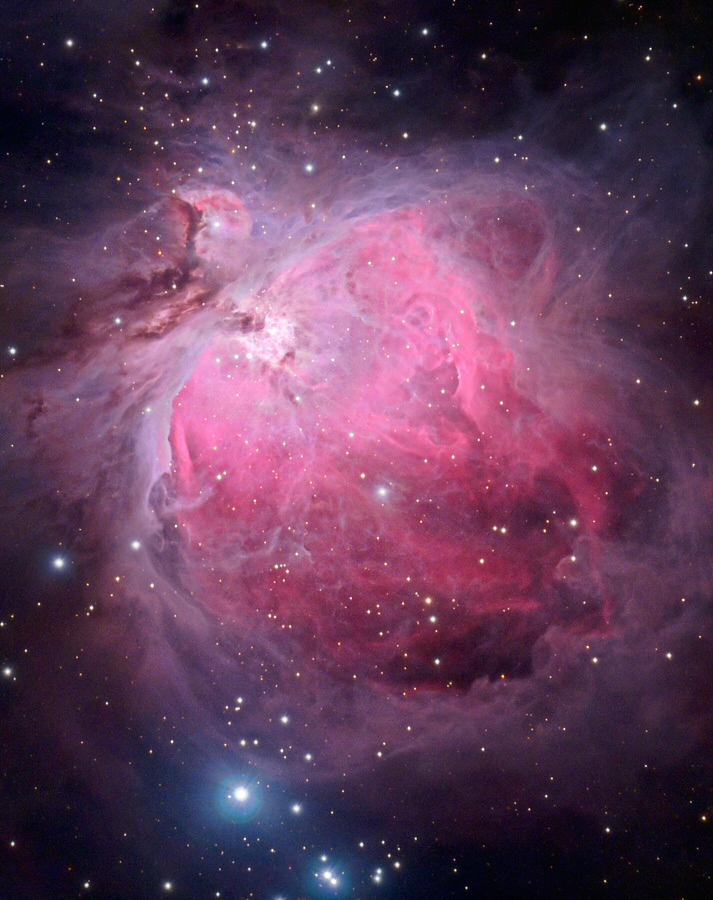
The Great Orion Nebula stands out as one of the most wonderful telescopic objects in the sky. The central area is the so-called Huygenian Region, which is a bright zone sharply bounded on the south side, into which protrudes a dark nebula, not unlike the Horsehead Nebula but more diffuse. The whole area is sprinkled with small stars, many of which are known to be "dust variables", which flicker as dust swirls in and out of their newly born atmospheres. In this region active star birth is taking place. Infrared images of the area "see through" the nebula and reveal young stars newly formed. In Hubble Space Telescope (HST) images the dark globules surrounding these stars can be seen. They are born in dense clouds of dust and gas from the nebula. The Trapezium at the heart of M42 is a remarkable multiple star with four easy components and two which are more difficult to observe, those are hot B-type stars belonging to the Orion Association which are quite young, born in the nebula itself. The three belt stars of Orion as well as the stars Rigel are also part of this association. The whole figure of Orion is alight with faint nebulous light coming from gas excited by these stars.
The Orion Nebula is located at a distance of about 1.500 light years.
 Orion Nebula Region, the full frame of this photograph.
Orion Nebula Region, the full frame of this photograph.
Exposure Data
Observing Hints
Orion is one of the most prominent constellations in the sky, and where to find M42/43 is no secret in the amateur community - in the sword of Orion, south of the hunter's belt. It is readily visible to the naked eye, and a 7x50 finderscope will easily show the nebula, with two bright stars embedded.
When viewing the M42 with small telescopes, only the central region and the dark intrusion from the northeastern side will be visible. The four Trapezium stars are already separable in a 60mm telescope at 40x and are a striking sight even in small scopes.
A 4.5" reflector shows more detail, but even better is the appearance of the nebula in a quality 4" refractor. The Orion Nebula is bright enough to be observable even under unfavorable conditions, but under a dark, transparent sky any telescope will extract the optimum of detail.
Viewing the nebula with a 6" telescope yields an edge more detail than with a
4". The faint extensions of the nebula become observable and in a night of
steady seeing the 5th and 6th Trapezium stars will be no problem. The Trapezium
stars are located in a sort of "wiped out" chamber within the nebula's center
and a strip of nebula seals the chamber to the dark intrusion. Further out,
another slightly interrupted filament of nebulosity crosses the intrusion, this
is the so-called "Schröter's bridge". It is not easily observable - you
will need a dark night and moderate magnification (80x- 100x) to find this tiny
detail. The central region, which is also called "Huygenian Region", is also
quite a sight at higher magnification - don't hesitate to use about 200x, with
that magnification a lot of structure will be visible, even in smaller
telescopes. M43, the small nebula surrounding the star just north of the main
nebula, has a typical comma-like appearance, observable in a 4" but easier to
see in a 6" telescope.
The outer parts of M42 require averted vision in a 6" to see all the detail
well, with this technique the curled structures at the east side and the sharp
nebula edge at the west side of the nebula become apparent. Another feature
worth mentioning is the ring-like structure which surrounds the southern part of
M42, it is separated from the main nebula by darker areas and therefore easy to
miss. This feature becomes conspicuous in a rich-field telescope (RFT) at low
magnification.
Nebula filters like UHC, OIII or H-Beta improve contrast when viewing the nebula in a not-so transparent night, and the nebula looks different in each of them, which makes their use interesting even in a superb night. However, in really good nights the nebula looks best without filtering. Even without filter the nebula appears in a ghostly green color to the eye when seen through moderate sized telescopes.
To see the pink color of the nebula appearant in color photographs more aperture is needed. The bigger the telescope, the more spectacular the amount of details visible becomes. High-quality optics are preferable, as some of the faint nebula filaments are only visible when contrast is high enough. In an 18" telescope the central part of the nebula is very bright, maybe even bright enough to ruin your dark adaption. The amount of detail visible is unbelievable and beyond description, detail otherwise only known from long-exposure photography becomes visible. Especially notable is the structure in and around the dark intrusion which extends towards the Trapezium from the northeast. M43 also quite a sight in an 18", with lots of dark structures etc. And it doesn't stop there, even bigger telescopes show even more detail...